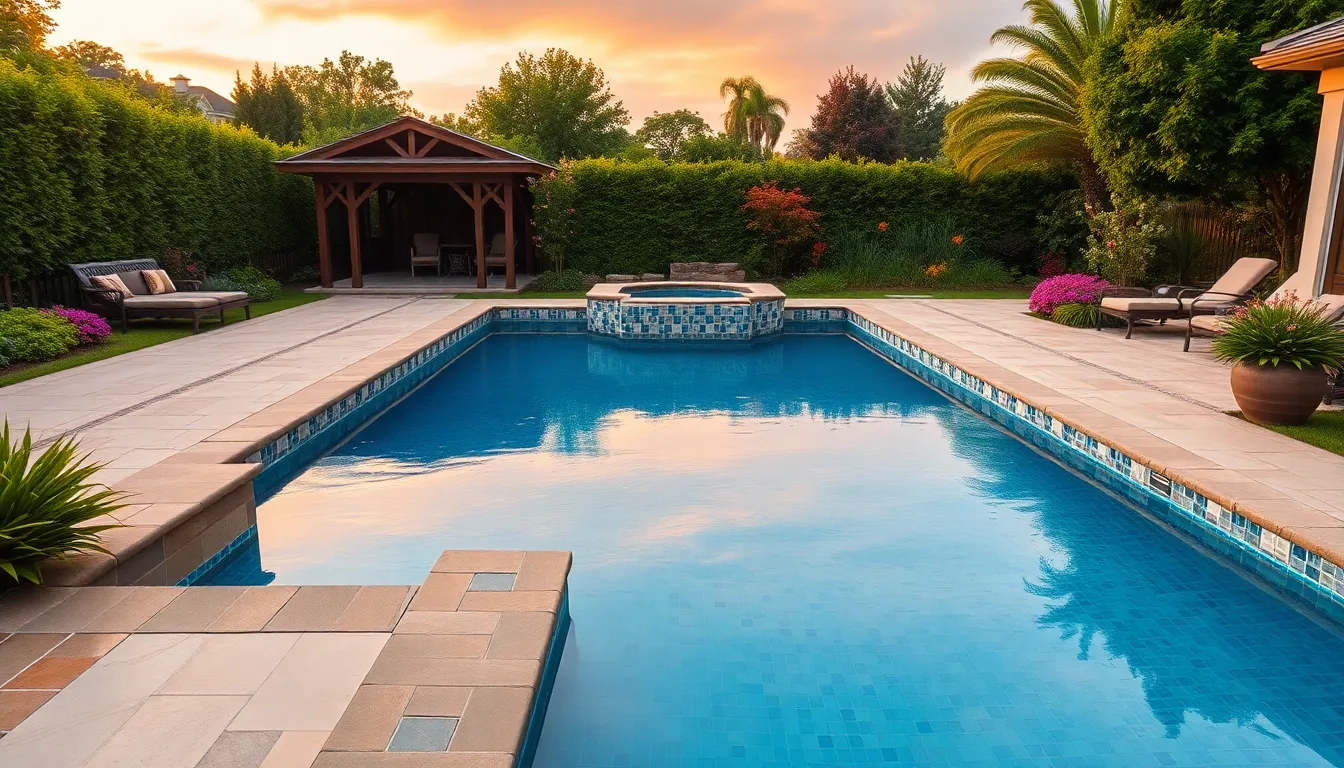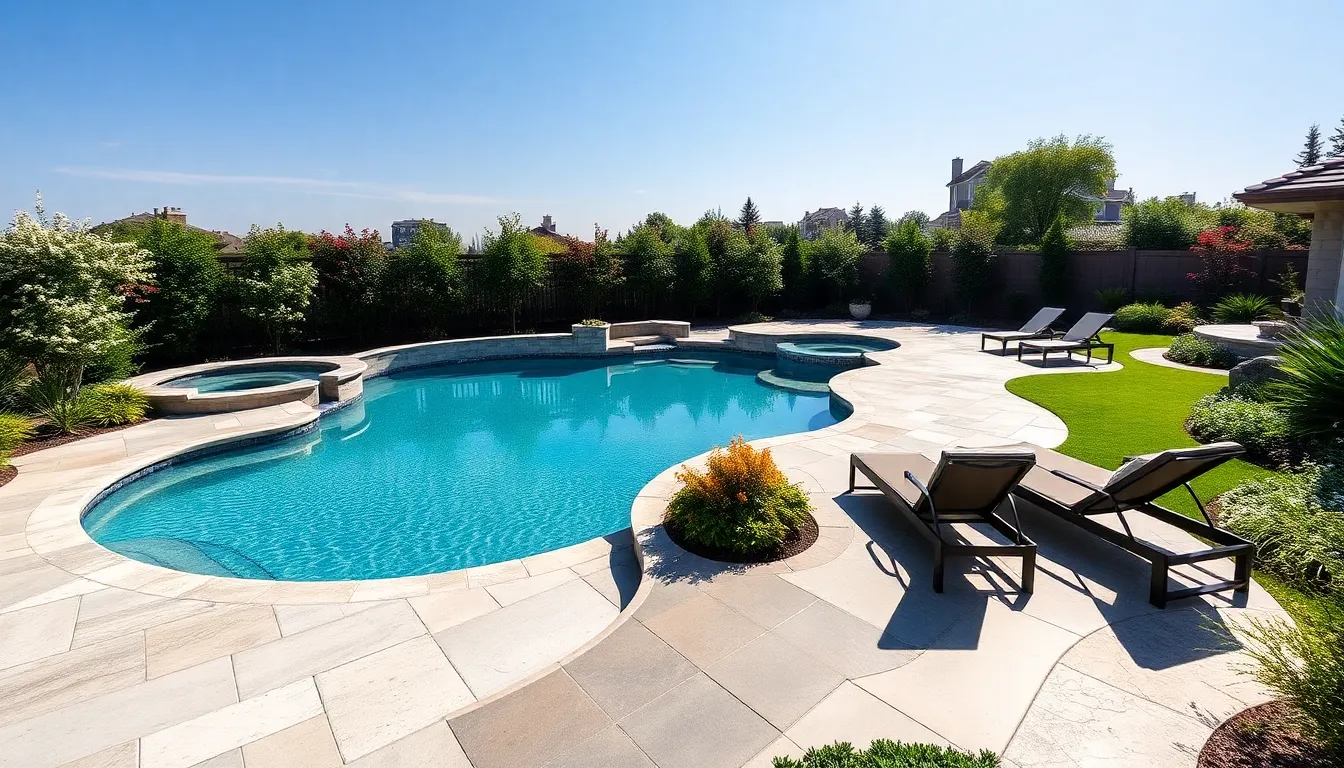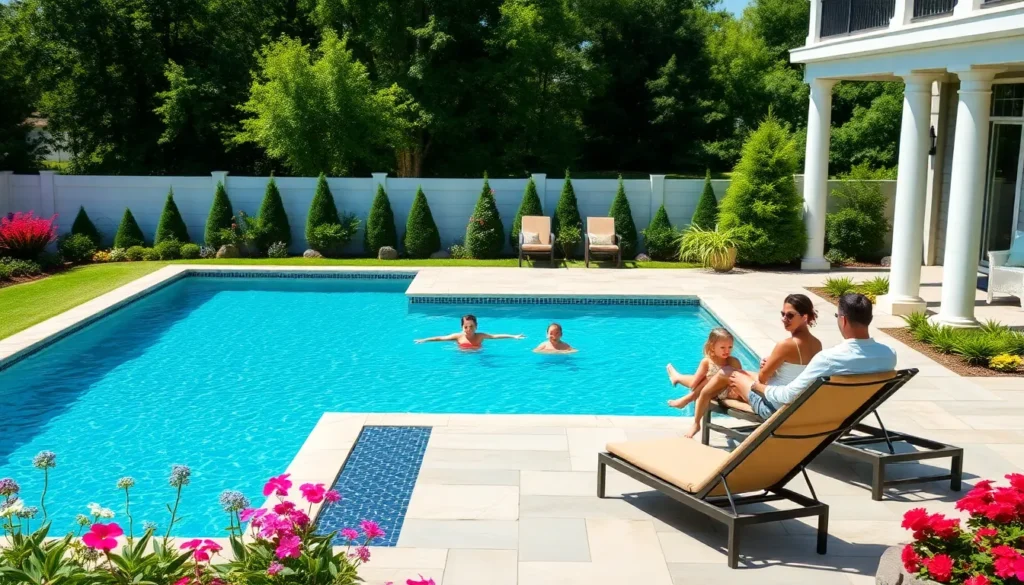A well-designed swimming pool can transform any backyard into a personal oasis. With the right elements, it becomes not just a place to swim but a stunning focal point that enhances the overall aesthetics of a home. As homeowners seek to create unique outdoor spaces, understanding the principles of swimming pool design is essential.
From choosing the perfect shape and size to selecting materials and landscaping, every detail matters. Whether it’s a sleek modern pool or a natural lagoon-style retreat, the design reflects personal style and lifestyle needs. Exploring the latest trends and timeless classics in swimming pool design can inspire anyone looking to make a splash in their outdoor living space.
Table of Contents
ToggleOverview of Swimming Pool Design
Swimming pool design encompasses various elements that contribute to the overall functionality and aesthetics of outdoor spaces. Understanding specific principles aids in creating a pool that complements personal style while meeting lifestyle needs.
Key Elements of Pool Design
- Shape: Choosing a shape impacts the pool’s visual appeal and usability. Options include rectangular, oval, and freeform designs, with each offering a unique atmosphere.
- Size: Determining the right size ensures adequate space for activities while balancing available yard dimensions. Common sizes range from 10×20 feet for small yards to larger sizes over 20×40 feet for expansive areas.
- Materials: Selecting suitable materials influences durability and maintenance. Popular choices include concrete, fiberglass, and vinyl, each presenting distinct advantages.
- Landscaping: Integrating landscaping enhances the pool’s environment. Features like patios, gardens, and lighting enhance ambiance and usability.
Current Trends in Pool Design
- Natural Pools: These eco-friendly options use plants and natural filtration systems instead of chemicals, promoting sustainability.
- Infinity Pools: Creating a seamless edge overlooking a view, infinity pools offer a luxurious aesthetic and often appear to extend into the horizon.
- Smart Technology: Incorporating automated systems for temperature control and lighting increases convenience and energy efficiency.
- Cocktail Pools: Smaller, shallow pools designed for relaxation and socializing are gaining traction, particularly for compact backyards.
Timeless Design Principles
- Functionality: Prioritizing practical use ensures the pool caters to recreational needs and enhances outdoor living experiences.
- Balance: Promoting harmony between the pool design and surrounding architecture creates a cohesive appearance.
- Color: Choosing color palettes that complement surrounding elements maintains visual interest while adhering to aesthetic principles.
By adhering to these guidelines and principles, pool designs not only serve recreational purposes but also elevate the overall beauty of outdoor spaces.
Key Elements of Swimming Pool Design


Understanding the key elements of swimming pool design ensures a harmonious integration into outdoor spaces. Two crucial aspects include shape and size considerations as well as material choices for construction.
Shape and Size Considerations
Shape and size significantly affect the pool’s functionality and aesthetic appeal.
- Shape Variety: Common shapes include rectangular, oval, and freeform designs. Rectangular pools often suit modern styles, while freeform pools provide a more organic look.
- Size Requirements: Size should accommodate activities such as swimming, lounging, or entertaining. A minimum of 12 feet in width and 24 feet in length is ideal for recreational purposes.
- Space Alignment: The pool’s shape and size must align with the yard’s dimensions. Proportional designs enhance balance and fit within existing landscaping.
Material Choices for Pool Construction
Material selection plays a vital role in durability, maintenance, and visual appeal.
- Concrete Pools: Concrete offers longevity and versatility in shape. Despite requiring higher initial costs, they allow for custom designs and finishes.
- Vinyl-liner Pools: Vinyl liners provide a cost-effective and quick installation option. However, they may require replacement every 5 to 9 years, reducing long-term durability.
- Fiberglass Pools: Fiberglass provides seamless construction and low maintenance. These pools can be installed quickly but come in pre-designed shapes, limiting customization.
- Tile Finishes: Tiling enhances the pool’s aesthetics and allows for unique designs. Selecting tiles resistant to fading and slipping increases their life span.
By carefully considering shape, size, and materials, designers create pools that fulfill personal desires and complement outdoor environments.
Aesthetic Features in Swimming Pool Design
Aesthetic features play a vital role in enhancing the visual charm of swimming pools. Carefully selected elements contribute to creating a serene atmosphere that transforms the pool area into an appealing oasis.
Lighting Options
Lighting options significantly enhance the pool’s atmosphere, providing both functionality and ambiance. Strategically placed LED lights offer various colors and intensities, allowing for customizable moods. Underwater lighting highlights the pool’s contours while creating a captivating view at night. Surface-mounted fixtures around the pool can illuminate pathways, ensuring safety and enhancing the overall design. By incorporating smart lighting controls, users can adjust brightness and color schemes to match specific occasions or personal preferences.
Landscaping Around the Pool
Landscaping around the pool adds another layer of beauty and integration with the surrounding environment. Plants like tropical shrubs and ornamental grasses soften hard edges, while flowering plants introduce vibrant colors. Hardscape elements, such as patios and walkways, create inviting spaces for relaxation and gatherings. Incorporating features like waterfalls or fountains enhances the auditory experience, providing soothing sounds that complement the visual appeal. By selecting climate-appropriate plants and materials, homeowners create sustainable, low-maintenance environments that enhance poolside leisure while showcasing natural beauty.
Functional Aspects of Swimming Pool Design
Functional aspects of swimming pool design encompass safety features and maintenance solutions, essential for ensuring enjoyment and longevity. Proper attention to these elements enhances the overall usability of the pool area.
Safety Features
Safety features play a pivotal role in swimming pool design, addressing potential risks for users. Fences reduce unauthorized access, providing barriers that keep children and pets safe. Pool covers offer an additional layer of protection, preventing accidental falls and retaining heat. Alarms, both on the pool and doors leading to the pool area, alert homeowners about unexpected entry. Non-slip surfaces around the pool’s edge minimize slip hazards, while adequate lighting improves visibility during evening use. These safety considerations create a secure environment conducive to worry-free enjoyment of the pool.
Maintenance and Cleaning Solutions
Maintenance and cleaning solutions contribute to the pool’s longevity and aesthetic appeal. Automated cleaning systems, such as robotic or suction cleaners, streamline the cleaning process, reducing manual labor. Chemical management systems monitor water quality, balancing pH and chlorine levels to ensure a safe swimming environment. Regular maintenance routines include skimming debris, brushing walls, and vacuuming the pool floor. Pool covers assist in keeping the water clean, minimizing the need for frequent treatments. By incorporating these solutions, pool owners can maintain pristine water quality, enhancing the overall swimming experience.
Trends in Swimming Pool Design
Current trends in swimming pool design focus on aesthetics, functionality, and sustainability. Many homeowners seek to create unique outdoor spaces that cater to relaxation and entertainment.
Natural Pools
Natural pools offer a chemical-free alternative, using biological filtration systems. They blend seamlessly into landscapes, often featuring native plants and stones. This design complements eco-friendly lifestyles while providing a serene environment.
Infinity Pools
Infinity pools create the illusion of water extending to the horizon, enhancing views in hilly or coastal areas. These pools attract attention and serve as luxurious focal points. The blend of elegance and modernity elevates outdoor aesthetics.
Smart Technology
Smart technology integrates controls for lighting, heating, and cleaning. Automated systems increase convenience and efficiency, allowing for remote operation via smartphones. Users experience enhanced comfort and safety in their pool environments.
Cocktail Pools
Cocktail pools, or plunge pools, are compact and designed for relaxation rather than swimming. They cater to urban environments, fitting comfortably in smaller backyards. These pools are perfect for socializing and create a stylish retreat.
Sustainable Design
Sustainable practices involve energy-efficient pumps, solar heating, and biodegradable materials. Designers emphasize eco-friendly choices that reduce environmental impact. This approach aligns luxury with responsibility, appealing to a growing market.
Integrated Landscaping
Integrated landscaping enhances the pool experience through well-planned surroundings. Features such as native plants, stone pathways, and seating areas provide a cohesive look. This design fosters a tranquil atmosphere while increasing property value.
Unique Shapes
Unique shapes break away from traditional rectangular designs. Freeform pools, geometric lines, or custom outlines create individuality. Tailoring the pool shape to the site maximizes space and visual interest, addressing diverse homeowner needs.
Incorporating these trends into swimming pool design transforms outdoor spaces into functional and visually appealing retreats. Designers strive to meet the evolving preferences of homeowners while keeping functionality and safety at the forefront.



